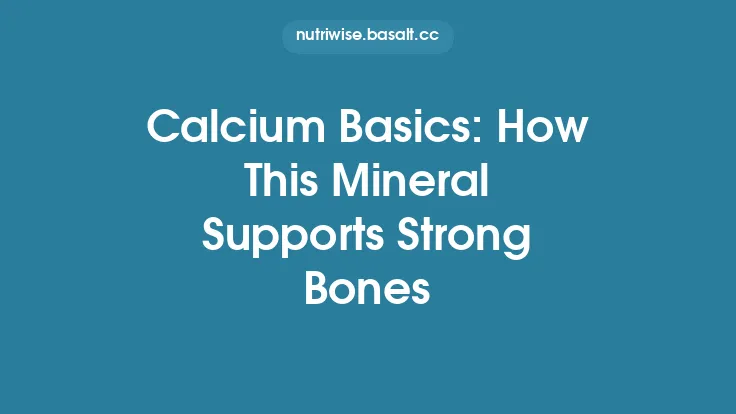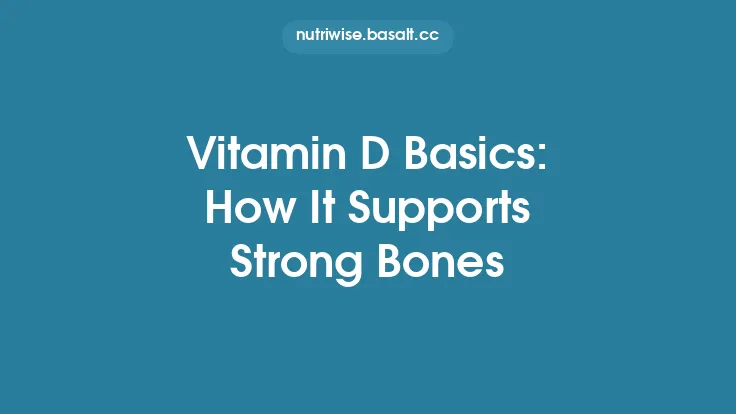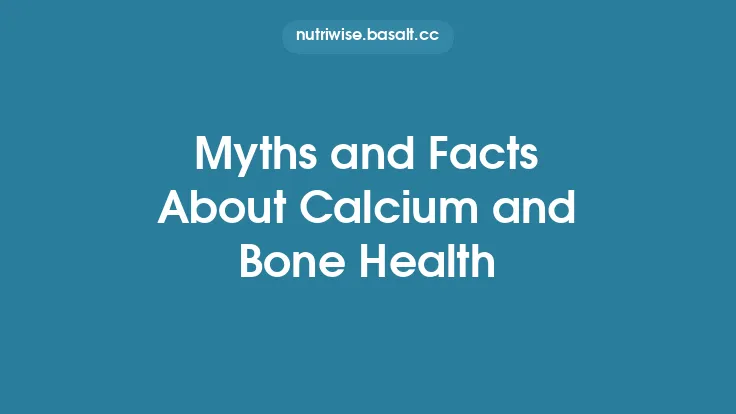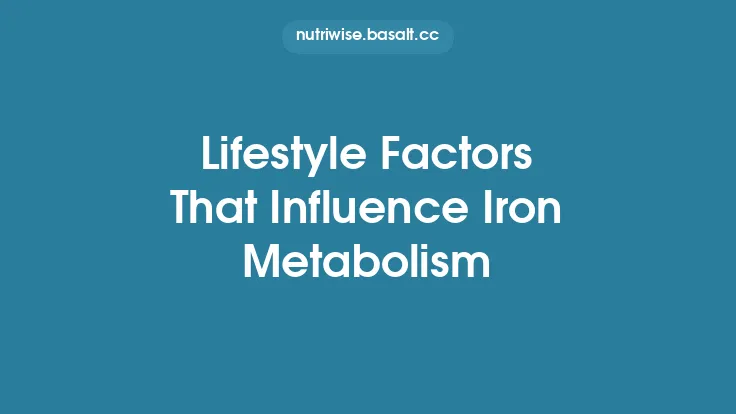Bone health is a dynamic, lifelong process that depends on more than just the amount of calcium you consume. While calcium provides the raw material for the mineral matrix of bone, the structure, density, and resilience of the skeletal system are profoundly shaped by the mechanical, hormonal, and metabolic environment in which that matrix is built and maintained. By adopting a suite of evidence‑based lifestyle habits, you can create conditions that continuously stimulate bone formation, slow resorption, and preserve the microarchitecture that keeps your skeleton strong and functional well into later years.
Weight‑Bearing and Impact Activities
Why they matter
Bone tissue responds to mechanical strain through a process called mechanotransduction. When muscles contract and generate force on the skeleton, osteocytes (the most abundant bone cells) sense the deformation and signal osteoblasts to lay down new bone while inhibiting osteoclast‑mediated resorption. The magnitude, rate, and frequency of loading determine the anabolic response.
Practical recommendations
| Activity Type | Typical Load | Frequency | Duration |
|---|---|---|---|
| Walking (brisk) | Low‑to‑moderate | 5–7 days/week | 30–60 min |
| Jogging / Running | Moderate‑to‑high | 3–5 days/week | 20–45 min |
| Jumping rope / Plyometrics | High (rapid impact) | 2–3 days/week | 10–20 min |
| Hiking (inclines) | Variable (incline adds load) | 2–4 days/week | 45–90 min |
| Stair climbing | Moderate | 3–5 days/week | 10–15 min |
Progression strategy
Start with low‑impact options (e.g., brisk walking) and gradually introduce higher‑impact or resistance‑based movements as joint health and fitness improve. The key is to provide a novel stimulus every 6–8 weeks to prevent the bone cells from adapting and plateauing.
Resistance Training for Muscular Pull on Bone
Mechanism
Resistance exercises generate tensile forces through muscle contractions, which are transmitted to the periosteal surface of bone. This “muscle‑bone unit” relationship is especially potent in the femur, spine, and forearm—sites most vulnerable to osteoporotic fractures.
Core components
- Compound lifts (e.g., squats, deadlifts, bench press) that engage multiple joints and large muscle groups.
- Progressive overload—increase weight, repetitions, or sets systematically (≈5 % per week) to keep the stimulus challenging.
- Tempo control—slow eccentric phases (3–4 seconds) enhance muscle tension and, consequently, bone strain.
- Frequency—2–3 full‑body sessions per week allow sufficient recovery while maintaining stimulus.
Sample routine
| Exercise | Sets × Reps | Load (% of 1RM) |
|---|---|---|
| Back squat | 3 × 8 | 70 % |
| Romanian deadlift | 3 × 10 | 65 % |
| Overhead press | 3 × 8 | 70 % |
| Pull‑up / assisted pull‑up | 3 × 6–8 | body weight |
| Farmer’s walk | 2 × 30 sec | heavy dumbbells/kettlebells |
Optimizing Protein Intake
Bone‑protein interplay
Collagen, the primary organic component of bone, is a protein matrix that provides tensile strength. Adequate dietary protein supplies the amino acids necessary for collagen synthesis and supports the hormonal milieu (e.g., IGF‑1) that drives bone formation.
Guidelines
- Quantity: 1.0–1.2 g/kg body weight per day for most adults; up to 1.5 g/kg for athletes or older adults engaged in resistance training.
- Distribution: Aim for 20–30 g of high‑quality protein per meal to maximize muscle protein synthesis, which indirectly benefits bone.
- Sources: Include a mix of animal (lean meat, poultry, fish, eggs, dairy) and plant proteins (legumes, soy, quinoa, nuts) to ensure a complete amino acid profile.
Micronutrients That Complement Calcium
While calcium is the cornerstone mineral, several other micronutrients act synergistically to improve bone quality:
| Nutrient | Primary Role in Bone | Food Sources |
|---|---|---|
| Vitamin K2 (menaquinone) | Activates osteocalcin, directing calcium to the bone matrix | Natto, hard cheeses, egg yolk, fermented soy |
| Magnesium | Cofactor for enzymes that synthesize bone matrix; influences parathyroid hormone regulation | Pumpkin seeds, almonds, leafy greens, whole grains |
| Phosphorus | Forms hydroxyapatite crystals with calcium | Meat, fish, dairy, legumes |
| Vitamin C | Essential for collagen cross‑linking; antioxidant protection of bone cells | Citrus fruits, berries, bell peppers, broccoli |
| B‑vitamins (B6, B12, folate) | Modulate homocysteine levels, which at high concentrations can impair collagen cross‑linking | Whole grains, legumes, leafy greens, animal products |
Ensuring a balanced intake of these nutrients—through a varied diet rather than isolated supplementation—provides a more stable biochemical environment for bone remodeling.
Maintaining a Healthy Body Weight
Low body weight
Insufficient mechanical loading due to low body mass reduces the stimulus for bone formation and is associated with lower estrogen and testosterone levels, both of which protect bone.
Excess body weight
While higher weight can increase loading, excess adiposity often brings chronic inflammation and elevated cortisol, which accelerate bone resorption. Moreover, visceral fat secretes adipokines (e.g., leptin, adiponectin) that can dysregulate bone turnover.
Target range
Aim for a body mass index (BMI) within 22–27 kg/m² for most adults, adjusting for individual frame and muscle mass. Combine moderate caloric intake with regular resistance and aerobic exercise to preserve lean mass while limiting excess fat.
Smoking Cessation and Alcohol Moderation
| Habit | Effect on Bone | Mechanism |
|---|---|---|
| Smoking | Decreases bone mineral density (BMD) by 5–10 % | Nicotine reduces osteoblast activity, impairs calcium absorption, and increases oxidative stress |
| Heavy alcohol (>3 drinks/day) | Increases fracture risk up to 2‑fold | Alcohol interferes with vitamin D metabolism, disrupts hormonal balance, and promotes falls through impaired coordination |
Action steps
- Smoking: Seek behavioral counseling, nicotine replacement therapy, or prescription medications (e.g., varenicline) as appropriate.
- Alcohol: Limit intake to ≤2 standard drinks per day for men and ≤1 for women; prioritize non‑alcoholic days each week.
Prioritizing Sleep and Stress Management
Sleep
During deep (slow‑wave) sleep, growth hormone peaks, stimulating IGF‑1 production—a potent anabolic factor for bone. Chronic sleep deprivation blunts this hormonal surge, diminishing bone formation.
- Goal: 7–9 hours of uninterrupted sleep per night.
- Tips: Maintain a consistent bedtime, limit blue‑light exposure after 8 p.m., and create a cool, dark sleep environment.
Stress
Prolonged psychological stress elevates cortisol, which directly stimulates osteoclastogenesis and suppresses osteoblast function.
- Mitigation strategies: Mindfulness meditation, yoga, regular moderate‑intensity exercise, and social support networks have been shown to lower cortisol levels and improve bone turnover markers.
Optimizing Gut Health for Bone Metabolism
The intestinal microbiome influences bone through several pathways:
- Short‑chain fatty acids (SCFAs) produced by fermentation of dietary fiber enhance calcium absorption and reduce inflammation.
- Modulation of immune signaling—a balanced microbiota curtails pro‑inflammatory cytokines (e.g., IL‑6, TNF‑α) that accelerate bone resorption.
- Bile‑acid metabolism—certain gut bacteria convert primary bile acids into secondary forms that can affect vitamin D activation indirectly.
Practical measures
- Fiber intake: 25–30 g/day from whole grains, fruits, vegetables, and legumes.
- Fermented foods: Yogurt, kefir, kimchi, sauerkraut, and kombucha to introduce beneficial lactobacilli and bifidobacteria.
- Prebiotic supplements (e.g., inulin, fructooligosaccharides) when dietary fiber is insufficient.
Reducing Sedentary Time
Even individuals who meet exercise guidelines can suffer bone loss if they spend prolonged periods seated. Micro‑loading—light activities such as standing, gentle walking, or using a standing desk—provides intermittent mechanical cues that keep osteocytes active.
- Rule of thumb: Stand or move for at least 5 minutes every hour.
- Tools: Timers, activity‑tracking apps, or a simple “hourly walk” routine.
Hormonal Balance Across the Lifespan
Sex hormones (estrogen, testosterone) are pivotal regulators of bone remodeling. Declines during menopause or andropause accelerate bone loss. Lifestyle interventions that support endogenous hormone production include:
- Resistance training (boosts testosterone and IGF‑1).
- Adequate dietary fat (especially monounsaturated and omega‑3 fatty acids) to provide cholesterol precursors for steroid hormone synthesis.
- Weight management (maintains aromatase activity in adipose tissue, which converts testosterone to estrogen in men).
When lifestyle measures are insufficient, medical evaluation for hormone replacement therapy may be warranted, but that falls under clinical management rather than lifestyle guidance.
Summary of Actionable Habits
| Habit | Frequency / Dose | Key Benefit |
|---|---|---|
| Weight‑bearing cardio (walking, jogging) | 5–7 days/week, 30–60 min | Mechanical loading, improved circulation |
| Resistance training | 2–3 sessions/week, full‑body | Muscle‑bone pull, anabolic hormone surge |
| Protein intake (high‑quality) | 1.0–1.2 g/kg/day, spread across meals | Collagen synthesis, IGF‑1 support |
| Micronutrient‑rich foods (K2, Mg, Vitamin C) | Daily | Enzyme activation, collagen cross‑linking |
| Healthy body weight (BMI 22–27) | Ongoing | Optimal loading without inflammatory excess |
| No smoking / limited alcohol | Continuous | Reduced osteoclast activation, better vascular health |
| Sleep (7–9 h) & stress reduction | Nightly & daily | Hormonal balance, lower cortisol |
| Gut‑friendly diet (fiber, fermented foods) | Daily | SCFA production, reduced inflammation |
| Break up sitting time | Every hour | Continuous micro‑loading |
| Hormone‑supportive lifestyle (exercise, healthy fats) | Ongoing | Maintains estrogen/testosterone levels |
By integrating these habits into daily life, you create a robust, multi‑dimensional defense against bone loss that goes far beyond the simple act of consuming calcium. The cumulative effect of regular mechanical stress, balanced nutrition, hormonal harmony, and healthy behaviors yields a skeletal system that remains dense, well‑structured, and resilient throughout the years.





